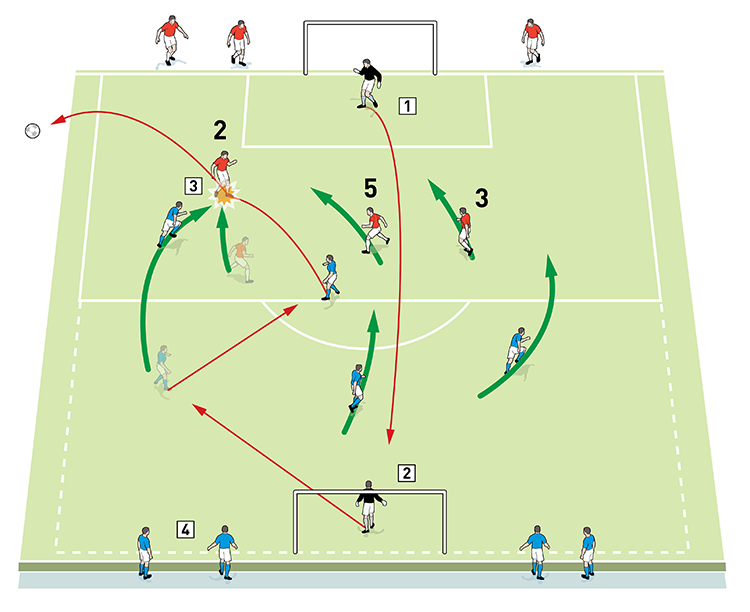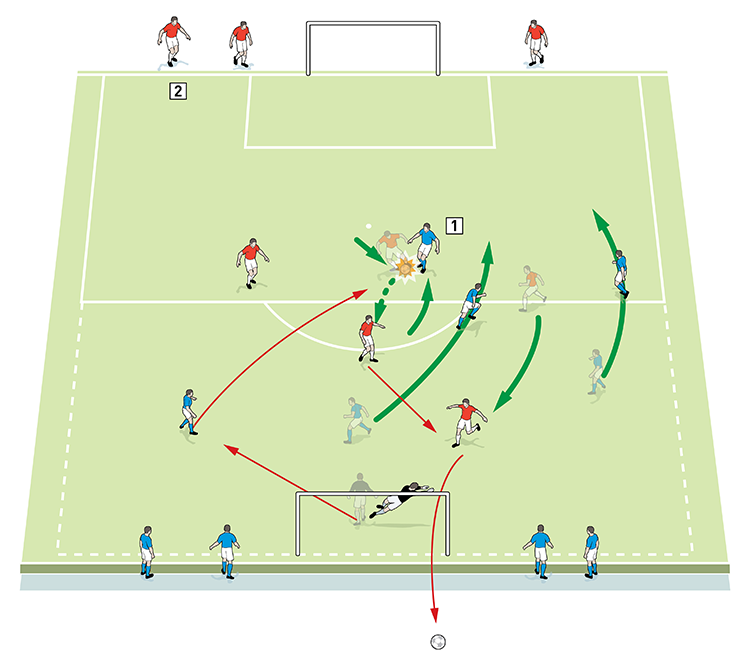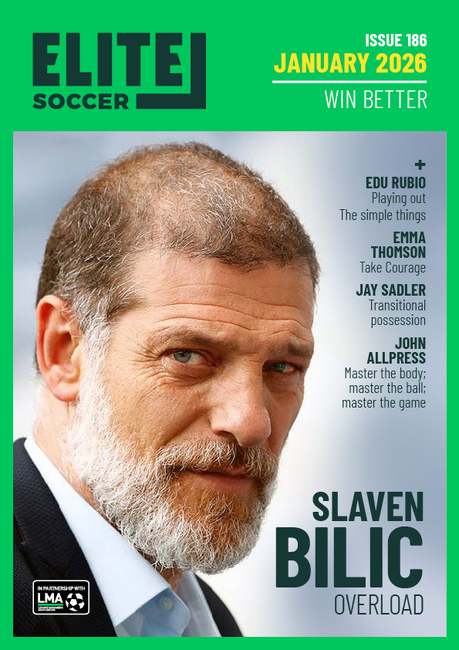




OUR BEST EVER OFFER - SAVE £100/$100
JOIN THE WORLD'S LEADING PROFESSIONAL DEVELOPMENT PROGRAMME
- 12 months membership of Elite Soccer
- Print copy of Elite Player & Coach Development
- Print copy of The Training Ground
Emergency defending with a back three
| Area | Up to three quarters of pitch |
| Equipment | Balls, bibs, cones, 2 full size goals |
| No. of Players | Up to 20 players + 2 goalkeepers |
| Session Time | Defending 3v4: 12mins, Coping with overloads: 30mins |
This training session is focused on making the three centre backs understand the four D’s – that they should delay, deny, dictate and defend when outnumbered. The practices create numerous occasions when players are exposed to stressful situations that are related to the area of the pitch in which they play and that are realistic to the game.
Most centre backs will be very positive about playing three at the back as they imagine themselves in the centre, having lots of time on the ball and being covered by other centre backs and wing backs. But in reality it can be very different, as wing backs have a tendency to push forward and leave the back three exposed.
When I became head coach at Salford City and the decision was taken to play with three new centre backs, I wanted the players to be able to deal with being outnumbered and tried to expose them to the worst case scenario in training. The whole point of this session is to expose the back three to chaotic situations that they may only face for a limited time in a game. Facing the worst case scenarios in training enables players to make better decisions when chaos appears within the game.
What do I get the players to do?
Defending 3v4
I set up in an area the size of two penalty boxes with a goal and goalkeeper at each end. The session starts with a 3v4 practice close to the goal, using a unit of three central defenders against a team of four attackers.
Play begins with a long throw or pass from the defending team’s keeper to the attacking team’s keeper, who plays the ball out from the back to launch an attack.
The three defenders must try to stop the attackers scoring, as shown [1a], and if they gain possession and manage to score in a counter-attack, their goal counts double, as shown [1b].
1a

2. The attacking team’s keeper receives the ball and plays out from the back to his team mates, who must build an attack on goal
3. The defending team is made up of three central defenders and they must react quickly to stop the attack
4. If they score, or if the ball goes out of play, the attacking team is replaced by a fresh wave of four attackers
1b

2. Every two minutes, the defending team is replaced by a fresh unit of defenders and the game starts again
The four attacking players are replaced with a fresh wave every time a goal is scored, or when the ball goes out of play. After two minutes a new unit of defenders enters the pitch and the game starts again.
Each team of defenders plays three games in total. It’s important to keep the intensity high to force the defenders to react quickly when making decisions.
How would you put this in a game situation?
Coping with overloads
I set up on a pitch with goals 70 yards apart and with four zones marked out, as shown [2]. I’m using two full teams of 11 including goalkeepers and I’m coaching the red defending team set up in a 3-5-2 formation. The blue attacking team line up here in a 4-4-2 but it could be any formation, depending on our next opponents.
2

2. Zone 2: Only reds 2, 4, 5 and 8 can enter. Blue attacking players 4, 8, 9, 10 and 11 can also enter, but the blue full back 3 can only enter, as here, if he passes into the zone first
3. Zone 3: Only red defending players 3, 4, 5 and 6 can enter, along with blue attacking players 4, 7,8, 9 and 10. The blue full back 2 can only enter after passing into the zone
4. Zone 4: All players can enter but 9 and 10 for the reds are locked in. Red wing backs 7 and 11 are also locked in but they can be released to defend if the coach holds their recovery run for 6-10 seconds
We play an 11v11 game with the following rules and restrictions:
Zone 1: All players can enter the zone.
Zone 2: The only red defending players that can enter this zone are numbers 2, 4 , 5 and 8. Blue attacking players 3, 4, 8, 9, 10 and 11 can also enter, but the full back (number 3) can only enter if following his pass.
Zone 3: Only red defending players 3, 4, 5 and 6 can enter this zone, along with blue attacking players 2, 4, 7, 8, 9 and 10, but the blue full back (number 2) can only enter if following a pass he made.
Zone 4: All players can enter but the red defending team’s strikers, numbers 9 and 10, are locked in. Wing backs 7 and 11 for the red defending team start locked in but can be released to recover after the ball has left the zone – control the time they are locked in, restricting their movement for between 6-10 seconds.
To cope with the overloads they face, the red defending team must show that they remember the four D’s: delay, deny, dictate and defend.
How do I progress the game?
To progress this exercise, lift all the restrictions and make sure the players implement what they have learnt from the practice.
What are the key things to look out for?
Decision making and communication are vital to the success of these practices. The session should be performed at a match tempo, which is important for realism and so the physical demands are high.
I want to see that players are utilising the four D’s at the right times . They should understand when to engage, when to apply pressure and when to stay compact. They should also understand the recovery lines needed to regain shape and they should hold the back line effectively, forcing attackers outside and blocking any routes to goal.
The attacking team are encouraged to recognise the opportunities afforded to them by the overload and they should counter-attack quickly and expose the space available in the attacking half.
What are the typical mistakes players might make and how do I avoid them?
This is as much a psychological test as it is tactical or physical. It enables players to accept responsibility in stressful situations and helps them to establish a togetherness, which is important.
Typical mistakes occur when players avoid taking responsibility, or press too early and either fail to delay attackers or delay them for too long when opportunities arise to pinch the ball.
We also sometimes see centre midfield players dropping too deep, or failing to drop into the back line when the ball goes down the side and the centre back is out wide in the full back position.
From a coaching point of view, it is important to be able to establish a team togetherness to see this situation out and to re-establish order from the chaos.
Related Files
Editor's Picks
Attacking transitions
Deep runs in the final third
Using the goalkeeper in build-up play
Intensive boxes drill with goals
Penetrating the final third
Creating and finishing
My philosophy
Pressing initiation
Compact team movement
Coaches' Testimonials

Alan Pardew

Arsène Wenger

Brendan Rodgers

Carlos Carvalhal

José Mourinho

Jürgen Klopp

Pep Guardiola

Roy Hodgson

Sir Alex Ferguson

Steven Gerrard
Coaches' Testimonials

Gerald Kearney, Downtown Las Vegas Soccer Club

Paul Butler, Florida, USA

Rick Shields, Springboro, USA

Tony Green, Pierrefonds Titans, Quebec, Canada
Join the world's leading coaches and managers and discover for yourself one of the best kept secrets in coaching. No other training tool on the planet is written or read by the calibre of names you’ll find in Elite Soccer.
In a recent survey 92% of subscribers said Elite Soccer makes them more confident, 89% said it makes them a more effective coach and 91% said it makes them more inspired.
Get Monthly Inspiration
All the latest techniques and approaches
Since 2010 Elite Soccer has given subscribers exclusive insight into the training ground practices of the world’s best coaches. Published in partnership with the League Managers Association we have unparalleled access to the leading lights in the English leagues, as well as a host of international managers.
Elite Soccer exclusively features sessions written by the coaches themselves. There are no observed sessions and no sessions “in the style of”, just first-hand advice delivered direct to you from the coach.







